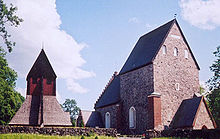Old Uppsala
Old Uppsala ( Gamla Uppsala ) is a historical settlement with important barrows and is now part of the Swedish crime scene Uppsala , in the Norra Staden district.
Old Uppsala was a center of power in central Sweden in prehistoric times. In the early Iron Age, the site was north of a bay and thus enabled trips to the sea and the adjacent lakes. The functions of the settlement can be compared with the later Stockholm . It was a religious and administrative center with a connection to the Baltic Sea. The declining importance of the square around the year 1100 is related to the change in the waterways due to the progressive land uplift.
archeology
In the last decades in Northern Europe in the course of the central square archeology , especially in places that are characterized by rich precious metal finds, halls have been discovered, also in Old Uppsala. These so-called “centers of wealth” have buildings that stand out in every respect from their surroundings. Because of the architectural features and the range of finds, they have been referred to as halls by northern European research since the 1990s.

In Alt-Uppsala there are three large barrows, which are often referred to as the royal tombs or Uppsala tombs . According to mythology and popular belief, three of the old Swedish kings of the Ynglinger family are to be found here . Some legends assign the graves to three Nordic gods ( Thor , Odin and Frey ). According to more recent dates, the hills are said to have been built between the years 475 and 550. They have a diameter of 55 to 70 meters and are seven to eleven meters high. They are therefore significantly larger than similar plants in the country. Directly next to it is a grave field from the earlier Iron Age . Boat graves from the Viking Age (800-1050 AD) were found in 2018 . Some smaller grave fields have fallen victim to agriculture over the years.
Excavations took place in two of the mounds in 1824 and 1847, during which, in addition to the cremated dead, personal items as well as animal and human sacrifices were found. The cremation must have been very violent, as only fragments were present of all the parts found. The Tingshügel is located directly to the east of the barrows . This is flatter and probably does not contain a grave, as it was the meeting point for the judiciary. Gustaf Wasa is said to have used the hill later for some of his speeches to the people. Overall, the grave field should contain 2000 to 3000 graves. Several older sources claim that there was a sacrificial site and holy well in this area, but their existence has not been scientifically proven.
In 2013, when a railway line was being built, the remains of two rows of eight to ten meter high wooden piles were found that had been placed vertically next to each other about 1500 years ago. One row consists of 144 piles over a length of almost one kilometer. A possible cultic function - for which the animal bones found there and thus possible sacrificial sites speak - stands next to the assumption that it is a territorial marking - for example of the access route to Old Uppsala.
Belief and religion
Old Uppsala was a religious center even before Christianization. The decisive change took place when Alt-Uppsala became the seat of the archbishop in 1164. The church was built on what was previously believed to be the pagan temple of Uppsala , described by Adam of Bremen in 1070 . He wrote that the temple was adorned with idols, a claim that seems dubious from today's perspective about the practice of religion in the Iron Age.
Around 1240 the church fell victim to a fire and around 1273 the archbishop's seat was moved to the new Uppsala. Construction of the cathedral had already started there. The new church in Old Uppsala is quite a bit smaller than the original one (see picture). It got its current appearance in the 15th century.
The Disagården open-air museum is located near the church .
Myth and History
With regard to the old descriptions of Alt-Uppsala's role in the unification of Sweden, it must be mentioned that these are only partially credible. For the time before the 9th century there are only myths, sagas and poetry. The so-called Ynglingatal reports that the Yngling dynasty is said to have ruled from Old Uppsala until the 7th century. The Heimskringla , a legend of the Icelandic Snorri Sturluson , reports that the kings Aun, Adils and Egil were buried in Old Uppsala in the 5th and 6th centuries. This fits in with the archaeological dates. Other poems in which Alt-Uppsala is reported are the English Beowulf , the Danish Chronicle Gesta Danorum and the Icelandic Hrólfs saga kraka .
In 2000 the Gamla Uppsala Museum opened near the burial site . Myths and the history of the square are presented here.
Personalities
The Swedish scholar Anders Celsius (1701–1744) is buried in the church.
Web links
Individual evidence
- ↑ Walter Christaller (1893–1969) was the founder of the “theory of central places” in 1933, the aim of which is to prove networks of neighboring mansions.
- ↑ Archaeologists discover a huge monument from the Iron Age. In: Süddeutsche.de , October 19, 2013.
Coordinates: 59 ° 54 ' N , 17 ° 38' E



